Home » 2021
Yearly Archives: 2021
Hiring a Professional for Tile Roofing Installation and Repair
Tile roofing is an excellent choice for any home. It’s a durable material that has a traditional history dating back to ancient times. While traditional roof tiles are usually made from slate or terracotta, modern materials can also be used. For example, some clay tiles have waterproof glazes that help keep rain and snow off of the building. And since it’s an excellent way to protect a house from the elements, it’s an excellent option for many types of roofs.

Roofing professional is the best option to clean and maintain your tile roofing. This way, you’ll avoid costly repairs or premature replacement. In addition to keeping a tile roof looking beautiful, it will last longer. It’s also better for your budget than to ignore small leaks and stains. In addition, if you notice cracks or chips on the tiles, you can easily replace them so that the damage won’t spread. Finally, having a tile roof is a good option because it can stand up to the elements.
The only drawback of tile roofing is its maintenance. If you’re not a handy person, you’re at risk of breaking a tile roof. You may also have to replace the underlayment, which is a standard part of the process. And if your tile roofing company doesn’t use a durable material like PVC or rubber, you’ll end up with a more expensive roof than you thought you’d have to spend. But this is all worth it when you see the long-lasting benefits that come with a tile roof.
While you can choose any material for your roofing, you have to be sure you hire an experienced contractor to install it properly. A tile roof will last for many decades if installed by a professional. However, hiring an experienced roofing contractor is vital because improper installation can cause the tiles to break or fall. Therefore, if you want your tile roofing to last as long as possible, you should contact an experienced roofer. Then, if you choose a tile roof, you can be sure that you’re making the right decision for your home.
You can find tile roofing contractors in your area using the Better Homes & Gardens local services website. These professionals can install a tile roof properly. First, they have to complete a training course that lasts a day. Then they’ll get the job done. To do this, you’ll need to ensure that the contractor you choose is certified for this type of roof. If you’re doing it yourself, you’ll need to ensure that your local laws comply.
In addition to being durable, tile roofing is also easy to install. Once you’ve completed the installation, it should last at least 50 years. You should also have a professional install the underlayment. The underlayment is the layer that provides additional protection against water damage. You should call a company with these services to learn more about the best tile roofing solutions for your home. There are several benefits to installing a tile roof on your home.
The cost of tile roofing will depend on its complexity and the region you’re in. Depending on the size of your roof, a new roof can cost anywhere from $8,500 to $30,000. The average tile roof contains 17 squares and costs anywhere from $5 to $18 per square foot. This means that a new tile roof can cover 1,700 square feet of space. But, because it’s a durable material, it will last for decades.
Despite their unique look, tile roofs are an excellent choice for homeowners who want a durable roof to protect them from weather and insects. They’re also an excellent option for those who want to add value to their home and make it more appealing to the eye. But, it’s important to note that tile roofing is not as durable as other types of roofing. So, you’ll need to consult a local roofing professional to determine which one will work best for you.
Despite its durability and resiliency, tile roofing is the most expensive material to purchase and install. However, a well-maintained tile roof can last up to 100 years if properly maintained. Unlike shingle roofs, tile roofs will last for decades if properly maintained. And, the most common cause of premature failure of a tile roof is poor maintenance. Broken or cracked tiles will allow water to run on the emergency underlayment.
Industry Roundup: Hydrogen-Fueled Equipment to Come in 2022
Hydrogen-fueled equipment to come in 2022
JCB is investing $138 million on a project to produce carbon-free hydrogen engines, the company announced last month. The first hydrogen-fueled machines will be ready for customers by the end of 2022.
According to JCB Chairman Lord Bamford, the company is investing in hydrogen because electric power has limits and is not an all-around solution, especially when it comes to larger machines. “We will carry on making engines, but they will be super-efficient, affordable, high-tech hydrogen motors with zero CO2 emissions, which can be brought to market quickly using our existing supply base,” says Bamford.
The company has already shown a prototype hydrogen-powered JCB backhoe loader. A second JCB machine – a Loadall telescopic handler – was unveiled October 19 at an event in London attended by Prime Minister Boris Johnson.

Firmatek acquired Kespry’s drone-based aerial intelligence platform.BuildwittDrone maker Kespry bought by Firmatek
Two leaders in the world of drone applications for the construction, mining and aggregate industries have joined forces. The combination of Firmatek’s drone-data processing and engineering services with Kespry’s drone-based mapping intelligence platforms will create new opportunities to deliver a vertical SaaS platform for drone-based analytics.
The acquisition will accelerate the use of artificial intelligence technologies and deep-learning frameworks to analyze and process topographic analysis of mining and aggregate worksites, increase data accuracy, improve site safety and eliminate potential risks.
“By combining Firmatek’s resources with Kespry’s expertise and leadership in AI-driven, SaaS software, we can provide better outcomes for our customers,” says Lauren Elmore, Firmatek’s chief executive officer.
Equipment World has reported on Kespry’s offerings several times in the last few years. To learn more about its technology, check out the links below.
With three big updates, Kespry gives construction customers little reason to take their drone data elsewhere
John Deere dealers to offer Kespry’s automated construction drone service in exclusive deal
Kespry Drone 2s brings centimeter-level survey accuracy, single base station setup to automated drone platform
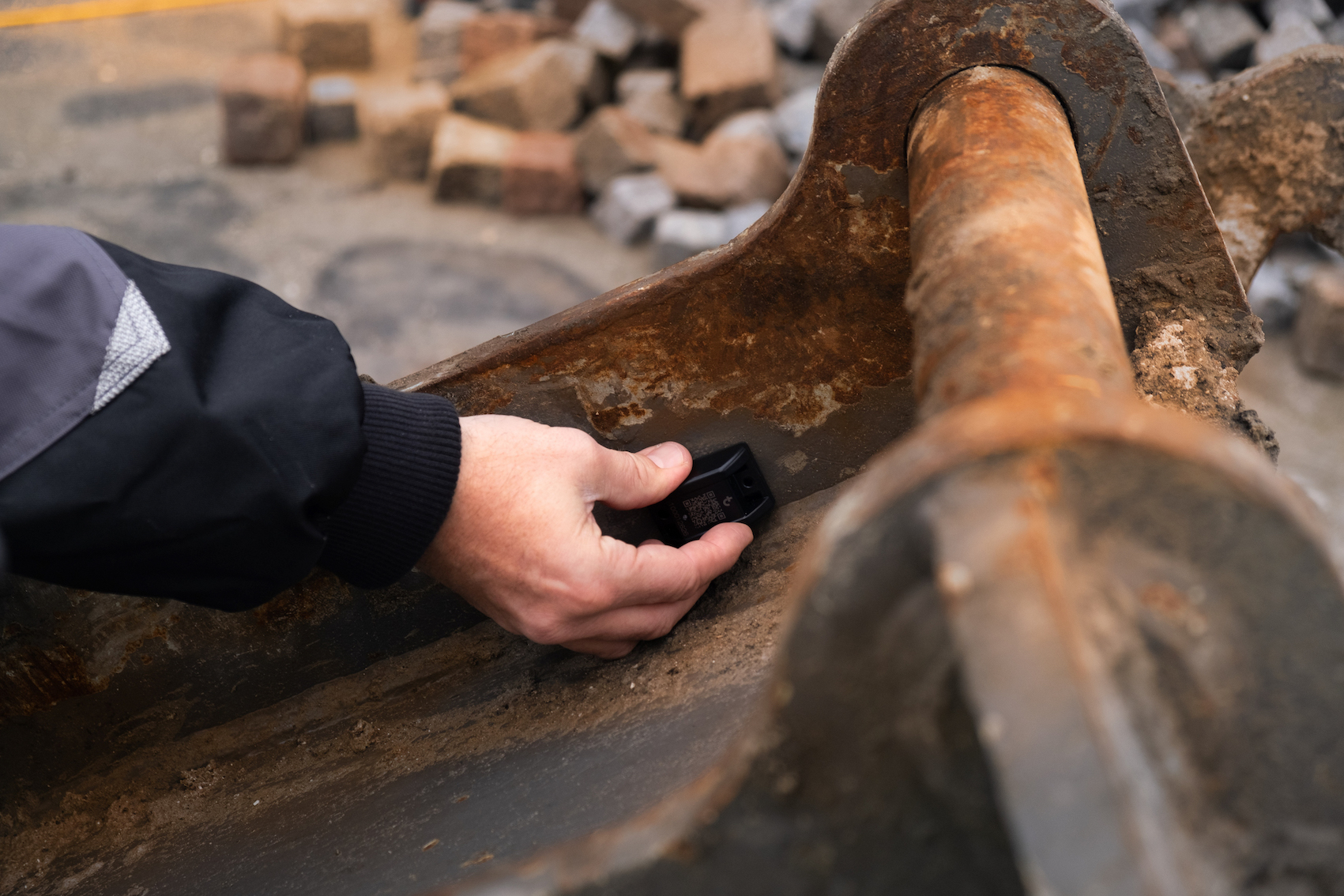
Tag tools and attachments with the Kin asset tracking system and you’ll always know where they are.TrackunitIf you can’t find a tool, try checking your Kin
Everybody knows that workers waste significant amounts of time searching for lost equipment. And according to Trackunit, only one out of five lost tools are ever found. One solution, announced at the ARA show in Las Vegas, is Trackunit’s new Kin Asset Utilization, which collects movement data from tagged assets and shows you in real time if the equipment is being used.
The Kin ecosystem resides within a platform to greatly increase the scope of data available to users and organizations and continues to enhance solutions in an ever more data-led construction market.
The Kin tags leverage the company’s mesh network and connect to the company’s Raw (TU600) installed network of devices via the Trackunit Manager and the Trackunit Go app. Each connected tag links to the TU600 network installed on machines around the globe, connecting the user and expanding the data available for business insights.

Couplers and work tools bearing this logo can work with any excavator from OEMs that are members of the Open-S Alliance.Open-S AllianceVolvo joins Open-S Alliance
Recently Volvo announced it has joined the Open-S Alliance. The alliance is a group of manufacturers that have agreed to design hydraulic attachments in such a way that their quick couplers and adaptors will work with any excavator regardless of the brand of the machine. This makes it easier for contractors to use different couplers, tiltrotators and work tool brands without being locked into a proprietary solution from one manufacturer.
The Open-S Alliance is a manufacturer-independent organization. There are three levels of membership: full, associate and supporting, depending on if Open-S products are developed, produced in-house or sourced. Since early 2021, Volvo CE has delivered quick couplers and adaptors directly from the factory and is now joining the Open-S Alliance as a supporting member.
Survey says data driving AEC transformation
More bricks than bytes, construction has been slow to adopt digital technology. But that is changing, according to a new report from Dodge Data & Analytics and Autodesk. The study finds the most frequently used BIM (building information modeling) technologies by architecture, engineering and construction firms are cloud computing (42%), model-based simulation (33%), virtual/augmented/mixed reality (28%), 3D printing (25%) and reality capture (25%).
The technologies best poised for growth, with a relatively high percentage of respondents who expect to adopt them in the next two to three years, include generative/outcome-based design (20%), 3D printing (19%), model-driven prefabrication (18%), model-driven simulation (18%), robotics/automated equipment (18%), reality capture (17%) and AI/machine learning (17%).
More details the free report can be accessed at www.construction.com
LiuGong Gears Up to Take on U.S. Construction Equipment Market
As supply-chain problems tighten construction equipment availability, LiuGong North America in Katy, Texas, says it has a compelling message to customers and potential dealers:
We’re here, we’re growing, and in some cases, we have inventory.
Earlier this year, LiuGong detailed a major revamp of its offerings to U.S. customers, including a transition from the E-series to the F-series excavators, a new line of Dressta dozers scheduled to debut in the second half of 2022 and the introduction of new wheel loaders over the next 24 months. This fall, the company had select models including its new F-series compact excavators displayed at both the Utility Expo and the ARA Show.
During the shows, Equipment World sat down with the LiuGong executive team to catch up.
With most of its products manufactured in China, LiuGong is seeing the supply constraints impacting the construction equipment industry. “I’ve not seen anything like this in 29 years of being in the industry,” says Kevin Thieneman, executive chairman and vice president. “We have to choose what we ship from month to month because you can’t get space on ships.”
Still, because China recovered earlier from the pandemic’s impacts and because more Chinese production is now directed overseas as domestic demand lessens, LiuGong North America finds itself in a better position than some of its competitors. It has inventory for sell, albeit much of it spoken for when it comes off a ship.
Take, for instance, LiuGong’s new F-series compact excavators, which LiuGong has limited inventory. “Availability equals retail at this point,” says Chris Saucedo, vice president and general manager, construction equipment, “and so just about everything that’s coming off the boat is already spoken for, and our dealers are working with each other to fill needs and get more business.”
Dealers, dealers, dealers
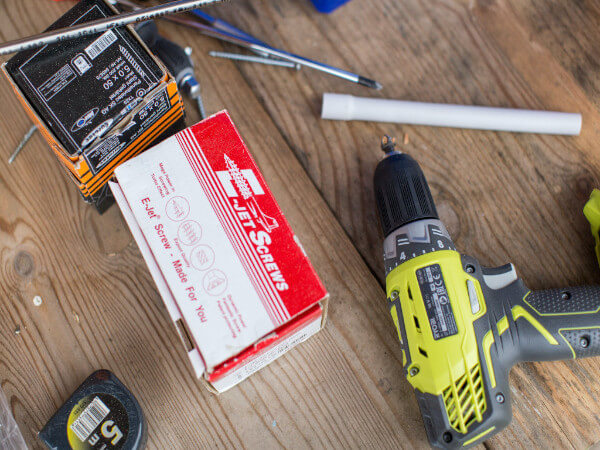
The green areas in this map indicate locations that LiuGong North America is targeting for dealer acquisition. (As of September, 2021; Alpha & Omega in Texas has since signed on.)LiuGong North America
Job number one for LiuGong North America is to strengthen its dealer network, says incoming president Andrew Ryan. “We have representation in about a third of the most important North American markets. We want to rapidly increase our representation, not by adding just numbers of dealers but by adding quality dealers that believe in our brand story.”
LiuGong is specifically looking for dealers in the Southeast, Pennsylvania and the central Midwest, among others. (See map above.)
“We don’t have any hard and fast rules about working with LiuGong at the expense of working with others,” Ryan says. Multiline dealers, he says, have an existing infrastructure that allows the company to build incremental relationships. “When you’re in a multiline dealer environment and that dealer is deciding to make an inventory investment with us or a competitive brand, that sharpens you.”
LiuGong’s vision here is to become a full-line OEM. Potential U.S. products waiting in the wings in the company’s plants in China include motor graders, compactors and backhoes. (LiuGong already sells Tier 3 versions of several products in Mexico.)
Another thrust for Ryan is to grow LiuGong North America’s aggregates business. “We’re asking our dealers to be prepared for expansion of our line into larger products over the next three to five years, specifically wheel loaders and excavators and, eventually, 100-ton rigid-frame haul trucks,” he says.
“Quarry and aggregates have been a great success for us,” Thieneman says, who also points out that KHL’s Yellow Table now ranks the global company as the 15th largest construction equipment manufacturer in the world, with more than $4 billion in sales revenues in 2020.
Another thrust is rental. The company has about 30 distributors, and about half of them are in the rent-to-sell space with a few in rent-to-rent. “It’s likely we will complement our dealers’ rent-to-sell strategy with certain regional account customers,” Ryan says. “We can be a very good supplier to a midsize regional rental company.” And in areas where there is no current dealer coverage, “there will be big opportunities for us to form relationships with rental companies, and perhaps see them choose to represent us as a dealer over time.”
Ryan is also working on building the North American team. “We want to make sure they feel empowered and entrepreneurial,” he says. “It’s a very different environment in this startup space than it would be with one of our more mature competitors. This is a see-a-problem-solve-a-problem kind of place.”
LiuGong also wants its dealers to know the brand’s clear expectations of product support. “You have to have buyer confidence that you’re going to be there long term after the sale,” Ryan says. “You’ve got the parts stocked, the technicians and the service infrastructure to keep customers running and productive.”
Head-to-head with the big guys
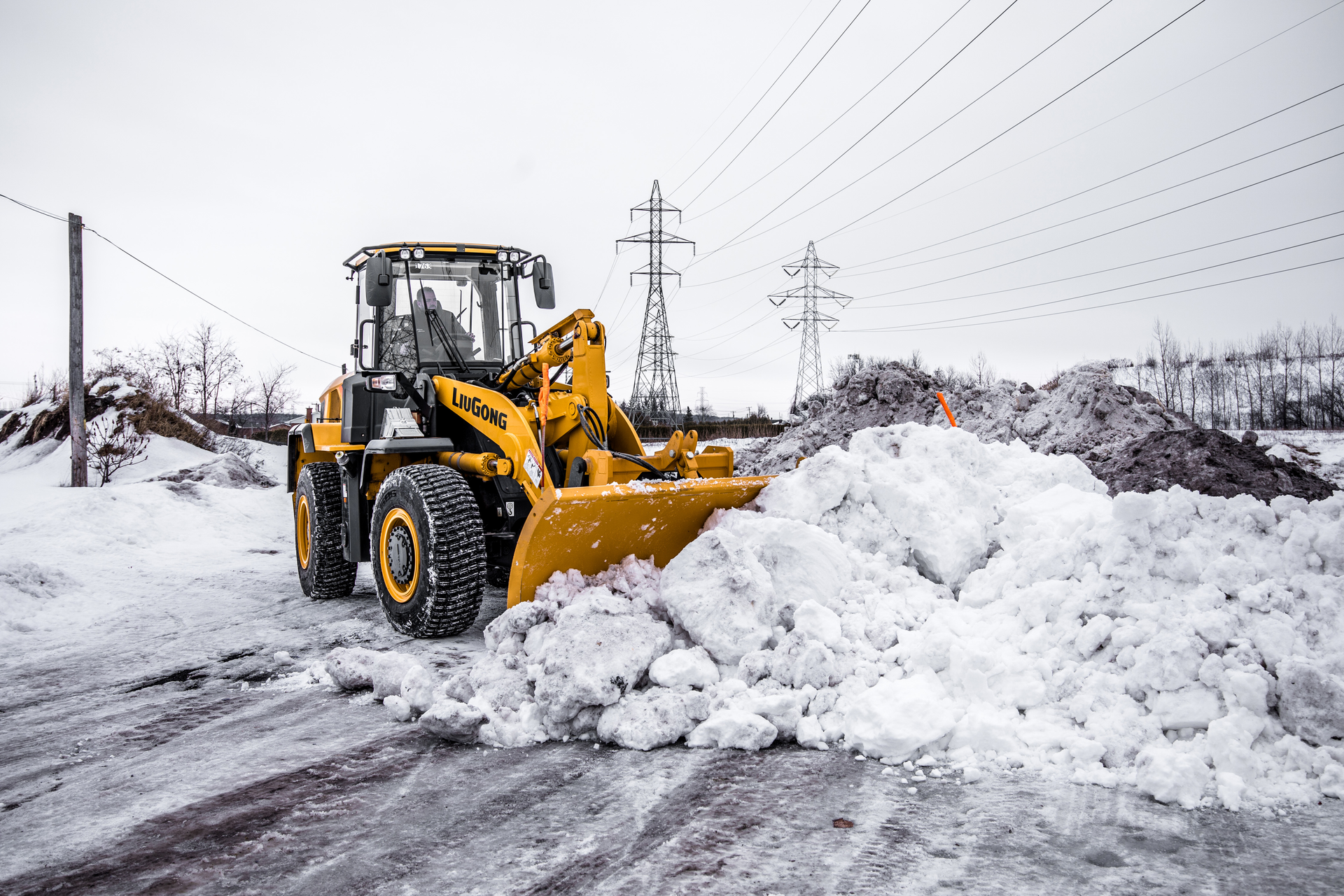
LiuGong’s 835 wheel loaderLiuGong North America
For those who hesitate to buy a Chinese-made machine, Thieneman points out that LiuGong produces global equipment. It uses Cummins engines and ZF transmissions. “When you break it down that way, it then becomes a question of dealer support.”
Moreover, the company will put its compact excavators “head-to-head with the big guys,” Saucedo says. “The product is very strong.” The 1.8-metric-ton 9018F and 2.7-metric-ton 9027F started arriving earlier this year. LiuGong will also introduce two additional models, the 4.5- and 5.5-tonne units, that will round out the F-series line, says Saucedo. The full-size excavator offering is now in transition, with the last E-series machine sold in September. The F-series full-size excavators will appear early next year.
Although LiuGong expected its revamped Dressta dozers to first make their appearance this fall, that schedule has been pushed back to Q2 next year. It now has five machines in a test program here.
Ryan comes to LiuGong after 25 years at Caterpillar where he worked on Cat’s expansion into the rental and compact equipment segments, along with working with dealers and in aftermarket parts. After a two-year stint in financial technology, Ryan returned to construction, signing on with LiuGong in late summer.
“We have that startup energy and the excitement of creation combined with the experience and financial capacity of a global brand,” Ryan says of LiuGong.
Court Extends Halt of Vaccine Mandate for Businesses of 100 or More Workers

A U.S. appeals court has extended the temporary stay of the Biden administration’s vaccine mandate until the case makes its way through the court system.
The 5th Circuit U.S. Court of Appeals based in New Orleans ordered November 12 that the vaccine requirements for businesses of 100 or more workers remain stayed and that the U.S. Occupational Safety and Health Administration take no further action to enforce its emergency temporary standard while a legal challenge makes its way through the court system.
The court ruled that OSHA overstepped its authority in requiring that employees of larger businesses be vaccinated against Covid-19 by January 4 or that they undergo weekly testing and wear a mask. The mask requirement for unvaccinated workers was to take effect December 5.
The court said “the stay is firmly in the public interest” and “the mandate has contributed to untold economic upheaval in recent months.”
“The public interest is also served by maintaining our constitutional structure and maintaining the liberty of individuals to make intensely personal decisions according to their own convictions – even, or perhaps particularly, when those decisions frustrate government officials,” the ruling said.
The order comes a week after the court issued a temporary stay on the mandate. It stems from a petition for review from a multitude of plaintiffs from several states, including the Trosclair family-owned supermarkets and businesses in Louisiana; the states of Louisiana, Texas, Mississippi, South Carolina and Utah; and various other businesses and groups.
They argue that the mandate adversely affects businesses that are already facing a worker shortage, and it would make it more difficult to hire and keep employees.
OSHA’s response to the petition says the emergency standard “is necessary to address a grave danger” and that the “legal objections lack merit.”
OSHA has also argued that the emergency standard is not a mandate because employees have a choice on whether to get vaccinated or get tested.
The standard does not require employers to pay for weekly Covid testing, and Covid vaccines are free. However, employers would be required to pay for time off for workers to get tested and vaccinated, as well as time off for any side effects from the vaccine.
Did you miss our previous article…
https://www.tortowheaton.com/?p=766
2021 Contractor of the Year: Pruss Excavation Refashions Fleet After Meeting Dual Flood Challenges
The construction lineage is deep in the Pruss family. Matt’s grandfather, Jim Sr., started Pruss Excavation in 1968. His father, also named Jim, joined him four years later, and Matt came on board in 2001.
But Matt’s start in construction goes much further back than 2001.

“I got on an excavator when I was 10 years old. When my dad told me to dig, I just kept on digging,” he says with a laugh. “Mom freaked out, but I enjoyed it.” And as he was growing up, both he and brother Scott, who now serves as superintendent with Pruss Excavation, pitched in when his father found himself shorthanded.
Matt went on to get a construction management degree, something he didn’t know was available until Freshman Day at the University of Nebraska. He had planned to go into business, but after the dean of the university’s construction management college learned his dad was a contractor, he convinced Matt to switch majors.
“We had some amazing professors who gave us real-world scenarios,” Matt says.
One example: it’s bid day and the students are estimating a project. The professor would go through the students with a handful of papers with vendor and sub quotes. “He would literally just throw them your way,” Matt recalls. “Some quotes didn’t have bonding and some didn’t include taxes, and you had figure out the good ones to develop the bid.”
Matt thought the exercise was exaggerated until he got back into the family business right after college. “It was not,” he says.

When Matt came on board, his father’s first instinct was to put him behind the controls of a machine, because he knew exactly how much operator/machine hours translated to the bottom line.
Matt had other ideas, though. Working in what then were company offices – in the basement of his parents’ home – he started estimating and soon bidding jobs that were outside of the company’s typical work of building terraces for area farmers.
“I know Pruss Excavation grew because of my education,” he now says. “We could get into the commercial side and chase bigger work.”
So the company began to expand, eventually moving from the basement office to a separate structure on the family farm in Dodge, Nebraska, one and a half hours northwest of Omaha.
Now Pruss Excavation logs $7 million to $10 million in annual revenues, has around 40 employees and does a variety of work, including dams and levees, roadwork grading, wetlands, landfill cell construction, site work and lagoons.
The transition from father to son was gradual as Matt took on bidding, contract management and submittals. And his brother Scott Pruss now manages several in-field duties, including serving as the firm’s quality control manager.
A turning point was a $3.4 million dam project in 2008; the company came in low by $13,000.
“It was a great job for us,” Matt recalls. Started right before the economy soured in the Great Recession, it also helped the company weather that economic storm.
Floodwaters
Pruss Excavation was to weather more storms, this time the meteorological variety. Major floods hit Nebraska in 2011 and 2019, and both changed the makeup of the company’s equipment fleet.
During the 2011 flood, Cat dealer NMC called and asked Matt if he still had the Challenger tractors with pull-behind scrapers. The company had eight at the time.
NMC was renting haul trucks to the U.S. Army Corps of Engineers on levee repair work after the flood, and the Corps decided the trucks weren’t the right equipment for the job. It was spending too much time building roads for the trucks and not enough time hauling dirt.
Pruss soon had six Challengers with pull-behind scrapers on the job and then bought five more from a dealer in Florida. Even that wasn’t enough, and it had to rent additional machines.
“By the time that project was done, we had 70 machines running, including 23 pull-behinds along with support equipment,” Matt says. “That was our huge, giant boost. Before, we were doing around $3 million a year, and with that project, we hit more than $8 million.”
It didn’t hurt that the job had a $43-an-hour federal wage. “I had guys from all over the country wanting to work for us,” Matt says. “Finding labor was not an issue.”
Of course, high demand comes with its own challenges. Pruss’s competition was doing the same thing, and everyone was scrambling for equipment and parts.
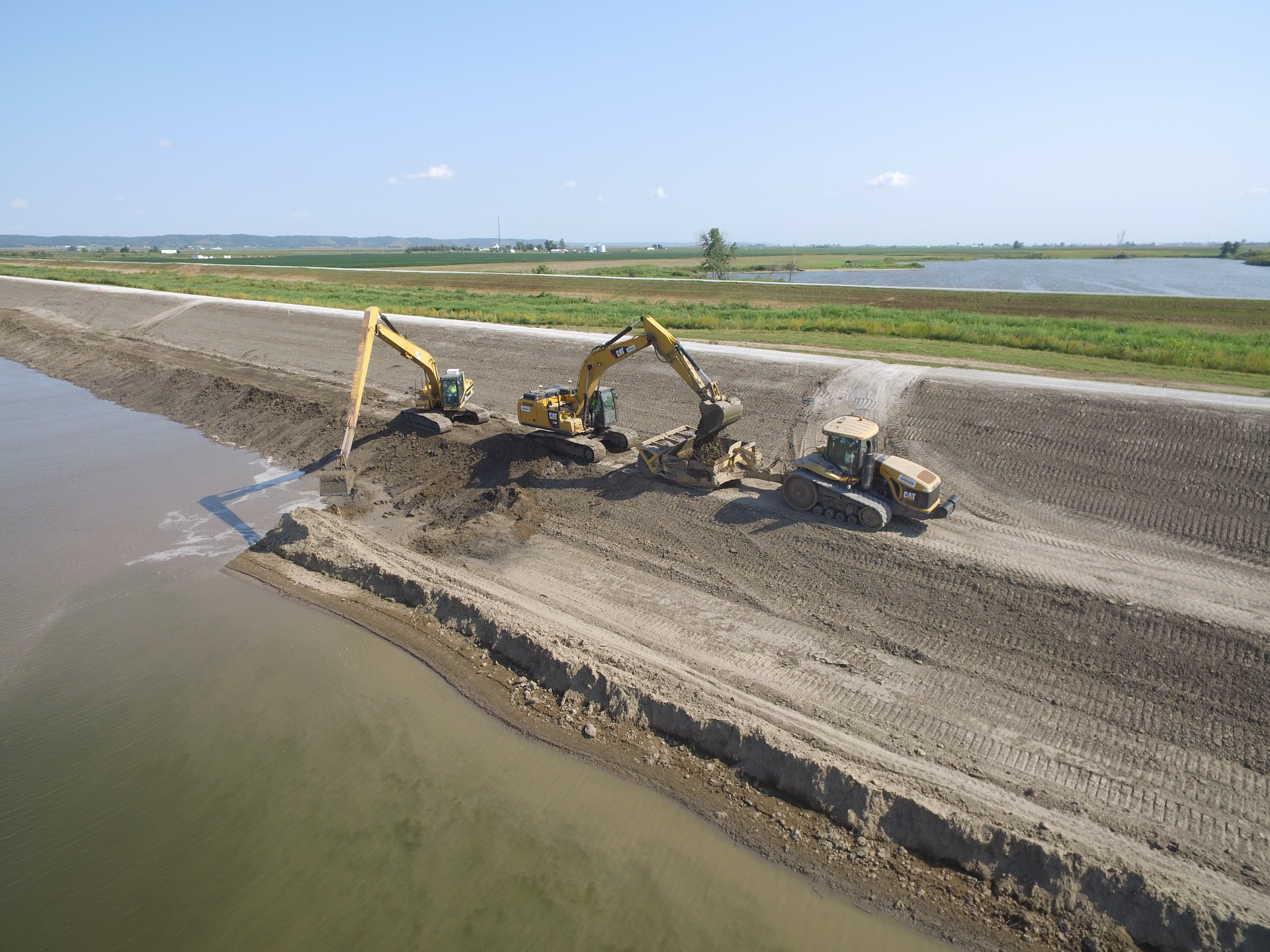
The 2011 and 2019 Nebraska floods helped Pruss Excavation up its equipment fleet and project management skills.Pruss ExcavationThe 2019 flood also had an equipment fleet impact, with Pruss buying six dozers to handle the flood mitigation work. “We were going in with 40 additional people, so I was buying things up like crazy,” he says. “We had nine dozers on that site running every day.” The job also racked up machine hours. “At one time we were working 12-hour days seven days a week. My operators were making amazing money.”
Pruss also put two mechanics on the 18-month job. “I knew stuff was going to fail and what we had to do to fix it,” he says.
In assessing the levee repairs done on the project, a reviewer with the U.S. Army Corps of Engineers ranked Pruss’s quality and scheduling as “exceptional.” The review said: “Not only was the levee repair a phenomenal effort and of exceptional quality, but the Pruss Excavation team even went out of their way to ensure that all work areas were clean and properly grade.”
The Corps took special note of how the two Pruss brothers worked together: “Matt and Scott’s combined teamwork really and truly enabled the success of this project…[they] were always synchronized in all efforts and activities and any absence by one was seamless with no disruption in performance.”
Regarding cost control, the Corps assessment added: “It was a skillful performance, and Matt’s pricing and responsiveness rivals that of much larger organizations observed over the past two years performing similar work. The best aspect of working with them is that they always construct a great product.”
Of course, the all-of-the-sudden levee repair work had to be managed with prior commitments.
“They had a very challenging project with us, and they continued to push through on our job and honor their obligations even while they were doing the levee work,” says Luke Ridder with Hawkins Construction.
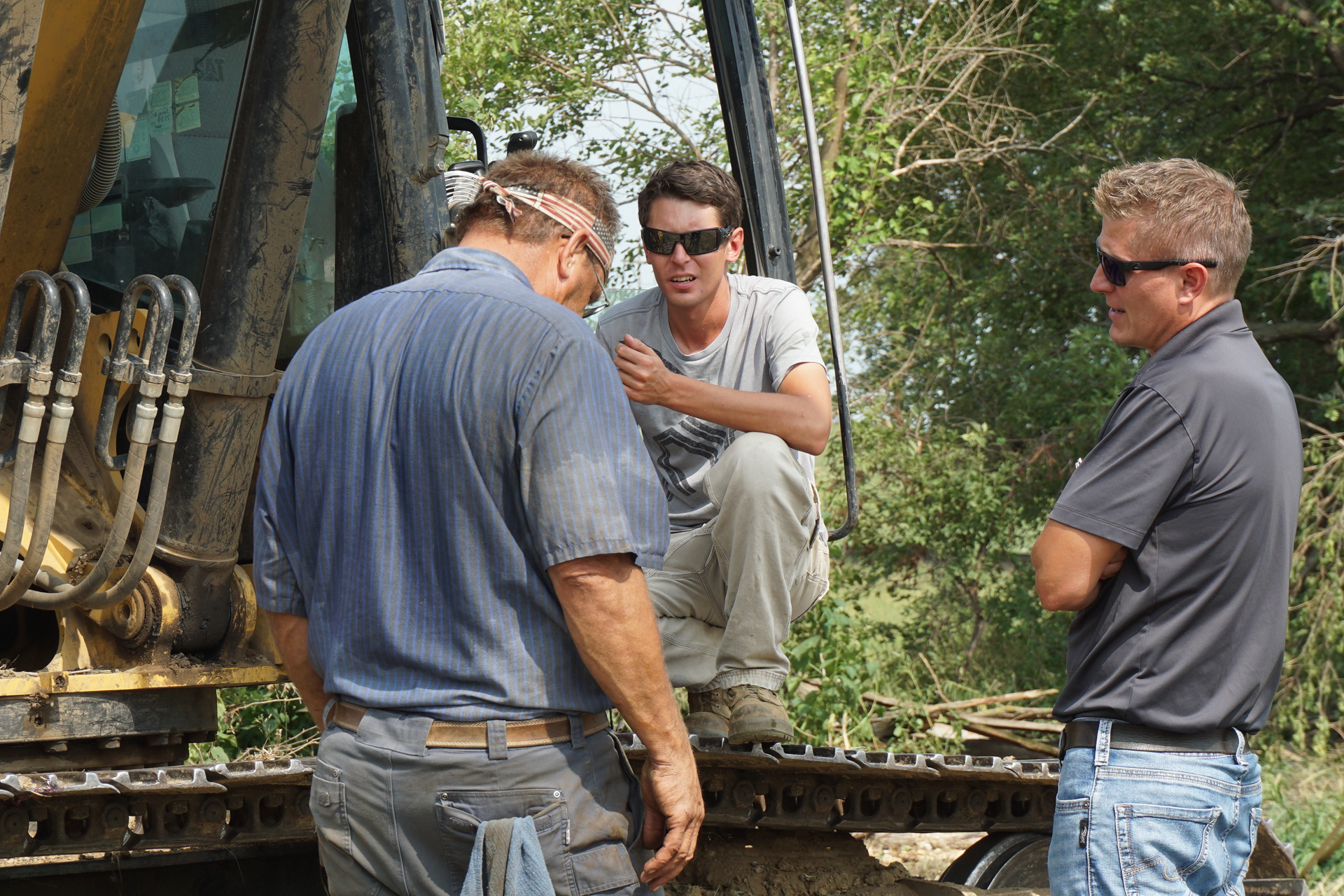
Pruss Excavation jobsite huddle.“A lot of contractors would just chase the flood work,” he adds, “but Matt stuck around, and he kept the job moving. It was a big deal. Matt knows he can’t just be an owner and pick up a paycheck. He’s very involved and he drives the ship on their modeling.”
This flood remediation experience came into play when the company bid on an emergency $1.05 million contract with a 144-hour turnaround. The job required over 33,500 tons of materials to be imported to close a breach that was 350 feet long and over 25 fee deep with flood water still flowing through it. “We had a pre-bid meeting at 1 p.m., they wanted bids at 4 p.m. and would sign the contract at 4:05 p.m.,” Matt says. “We were low by $11,800 and got it done early.” The project required a dozen operators and 30 trucks.
“A week later we were low bid on another fast-track levee repair,” Matt says. “We were low by $55,000 on a $2.8 million contract with a 168- hour completion. We successfully completed that repair on-time as well.”
Matching fleet to job demand
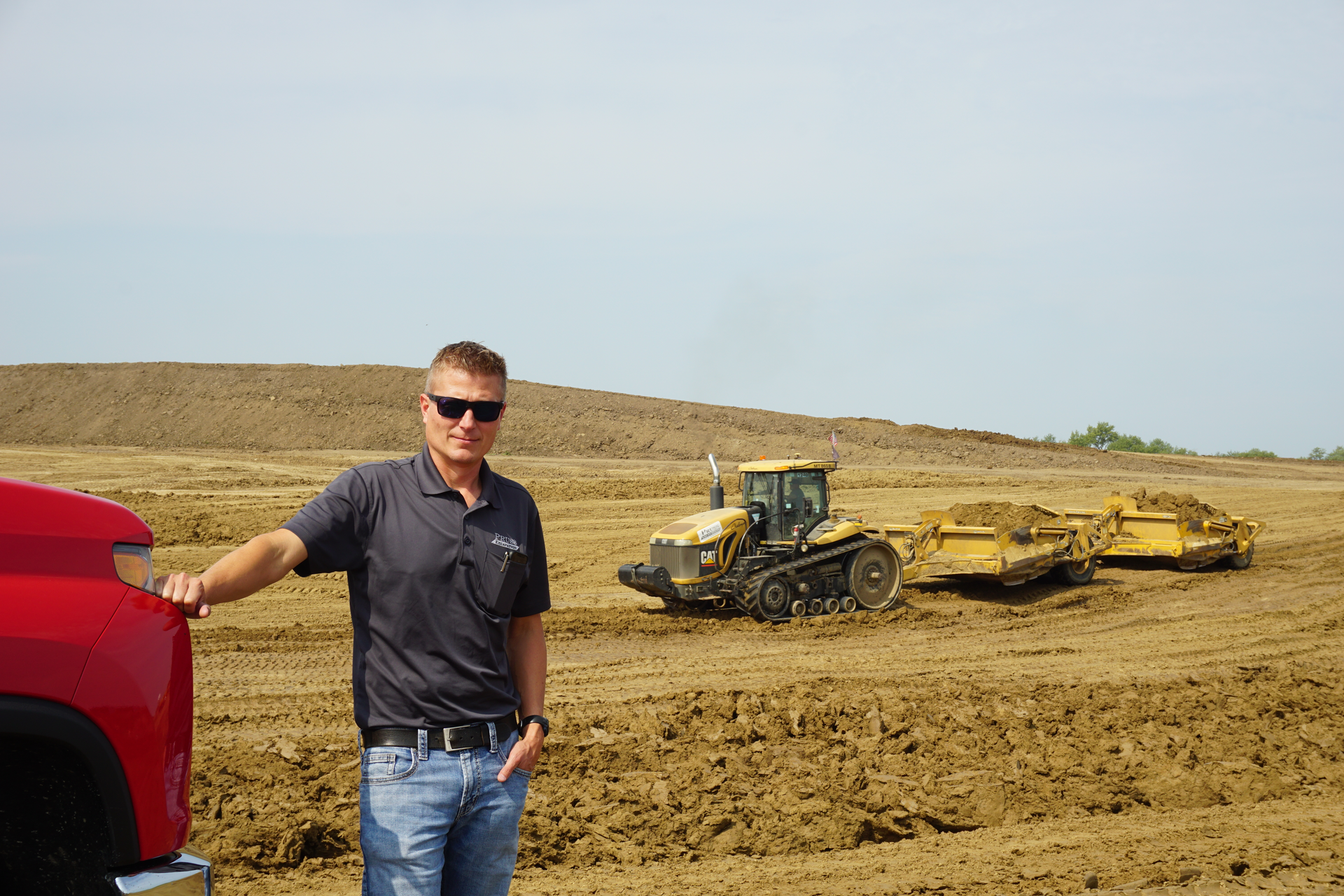
The company’s fleet of pull-behind scrapers — now at 32 — has helped them tackle wet conditions.
“We have had more machines than people throughout the years, and we’re still that way,” Matt says. This also allows Pruss Excavation to stage an upcoming jobsite while finishing another and thus lessen time spent on mobilization.
Its fleet of pull-behind scrapers now numbers 32. “Pull-types are awesome in the wet and the sand,” Matt says, noting that the company also uses Cat 627 self-propelled scrapers in drier conditions.
Although the bulk of his fleet is in the large machine category – including dozers, excavators, articulated trucks, scrapers and scraper tractors – Matt also uses skid steers as support machines. “We’re also heavy into Topcon GPS,” he says, “and in addition to dozers, scrapers, and motor graders, we also put the excavators on grade control. We’ve found it very user friendly.”
While operators are responsible for daily greasing, Pruss uses NMC to handle PM tasks. “They’ll service my entire fleet, no matter the brand,” he says. Engine, transmission and other major repairs go to dealers.
Today’s machine telematics also help with service, he says. “When we get a warning, dealers can diagnose and know where the machine is and what they need to fix it.”
But he’s also learned these convenient diagnostics can eat up tech time if an easy fix is not readily apparent. “I always press my dealers for warranties that cover diagnostics,” Matt says. “I don’t want to be billed for the time it takes them to figure out a problem.”
Legacy
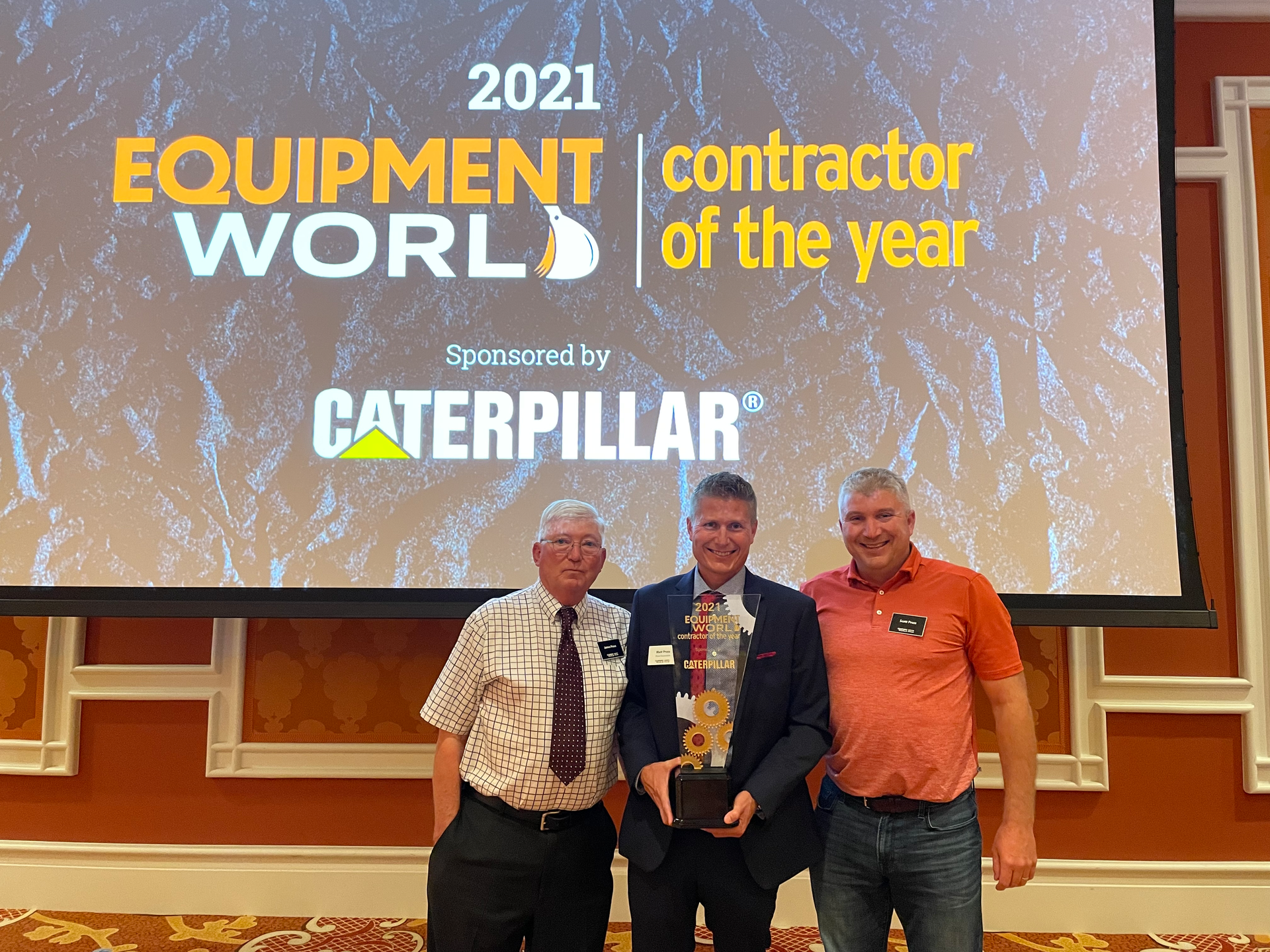
Father Jim Pruss (left) and brother Scott Pruss (right) flank Matt Pruss at the Contractor of the Year event.
Being named the 2021 Contractor of the Year has special resonance for Matt: His father, Jim Pruss Jr., was named a Contractor of the Year finalist in 2004. Both his father and brother attended the Contractor of the Year event last month and witnessed his win.
Neither is surprised he came away with the award. Matt’s clients and vendors also notice his attention to detail in how he approaches his jobs.
“He’s a heck of a businessman,” says his dealer representative Kevin Peterson with NMC. “And you can see it in the way he’s grown.”
“They know the type of leadership it takes to run a great small business,” says Ridder. “They just get it done.”
“We let our work to speak for us,” Matt says. “We want to under-promise and over perform instead of the other way around.”
Watch Matt Pruss receive the Contractor of the Year award below:
CMSBrowserComponents.load({ el: ‘#vue-1635193269032-615’, name: ‘OEmbed’, props: {“mountPoint”:”/__oembed”,”url”:”https://www.youtube.com/watch?v=PW21SPuw1TQ”,”attrs”:{“type”:”oembed”,”id”:”https://www.youtube.com/watch?v=PW21SPuw1TQ”,”element”:”aside”}}, hydrate: false });
2021 Equipment Rentals Up 3%, But Hang On for Big Growth Next Year
Rental equipment revenue will grow a moderate 3% over 2020 through the remainder of 2021 – but hang on in 2022.
The American Rental Association says it now expects the combined construction/industrial and general tool rental revenue to grow by almost 10% next year, reaching a record $52.4 billion. That number even tops the rental industry’s 2019 height of $50.9 billion.
The news is even brighter for the construction equipment segment, which ARA forecasts will grow 12.3% in 2022, reaching $38.7 billion. ARA says it did not include the impact of the proposed infrastructure bill now making a tortuous path through Congress in its calculations.

American Rental AssociationJohn McClelland, ARA vice president for government affairs and chief economist, says most of the benefits of increased infrastructure spending will not occur next year since it takes time for projects to be approved and funding obligated. IHS Markit, which produces the ARA forecast, will incorporate the infrastructure spending “once we have a clear indication of final passage” of the bill, McClelland says.
IHS is monitoring the market to see to what degree inflation which has not been an issue for more than a decade is inflected in rental-rate increases.
ARA also issues a five-year projection with each forecast. It now projects rental revenues to grow 5.5% in 2023, 2.5% in 2024, and 3.3% in 2025 to reach $58.6 billion.
ARA says rental companies slashed construction equipment and general tool capital expenditures by 44.4% in 2020, dropping equipment investment to $7.64 billion. Now on the rebound, ARA predicts equipment investment will grow by 36.2% this year to $10.4 billion, followed by another 36% increase to $14.2 billion in 2022. Additionally, this investment will grow by 10.9% in 2023, 2.3% in 2024 and 3.8% in 2025 to total more than $16.6 billion, according to ARA.
Did you miss our previous article…
https://www.tortowheaton.com/?p=568
Cat 578 Forest Machine Boosts Operator Comfort, Productivity

Caterpillar upgraded its 568 Forest Machine with new features to boost productivity, comfort and safety and reduce maintenance time and cost.
With a 347-horsepower Cat 9.3B diesel engine, the 568’s electrohydraulic control system puts out 10% more swing torque and 14% more drawbar pull, which makes grabbing and moving heavy logs faster. Smart mode controls match engine output and hydraulic power to the load resulting in 5% lower fuel consumption.
The reinforced certified forestry cab structure and 1.25-inch-thick polycarbonate windshield protects you from logs and limbs that may break loose while loading. The interior of the heated and cooled cab has been increased 25%, which allows most operators to stand up without hitting their head. Cat also narrowed the cab pillars and added larger panoramic windows and a flat hood to give you 50% more visibility. For cab access, you have the option of side or rear entry. A rearview camera comes standard, and three cab riser heights are available: 22, 48 and 72 inches. For easy transport, the cab tilts with hydraulic assist.
The new electrohydraulic control system eliminates the need for a pilot filter and pilot oil. Fuel-filter change intervals have been pushed out to 1,000 hours, double the life of the previous model. And the hydraulic-oil return filter offers a 3,000-hour service life, 50% longer than the previous forest machine. The on-demand cooling fan works only when needed, and the fan reversal can be programmed to come on at different intervals to clean out debris.
If you’ve grown to like push-button start on your truck, you’ll appreciate the same option on the revamped 568. Starting can also be accomplished with Bluetooth key fob or a unique operator ID function. With the operator ID, you can program the machine to remember individual settings and attachment preferences using the 10-inch-high resolution touchscreen.
If you’ve had trouble locating attachments in the past, Cat’s PL161 Attachment Locator can help you find where you last put your work tool, even if it’s overgrown with debris or vegetation.
Given that many forestry operations are in extreme cold or hot weather, the Cat 568 boasts a cold-start capability down to minus-32 degrees Fahrenheit and in hot weather up to 126 degrees. And should your contract call for cutting trees high up in the mountains, the 568 will operate without derating at altitudes up to 9,842 feet above sea level.
Cat 568 Quick Specs>
Engine: 347 hp>Operating weight, forestry: 104,280 lbs.>Operating weight, log loader: 105,380 lbs.Max reach, forestry: 38 ft. 4-in.Max reach, log loader: 2 ft. 5 in.Drawbar pull: 84,978 lb.-ft.Swing torque: 120,222 lb.-ft.
Did you miss our previous article…
https://www.tortowheaton.com/?p=565
Snyder Wins AEMP Technician of the Year: “He’s motivated by big jobs and challenges.”
Chase Snyder of Manatee County, Florida, has been named the 2021 Technician of the Year by the Association of Equipment Management Professionals Education Foundation.
Coworkers and supervisors at Manatee County government described Snyder as always willing to tackle the big mechanical problems, having a strong work ethic and constantly looking for ways to save taxpayers’ money.
Snyder is a senior fleet technician for Manatee County’s landfill shop, where he has worked for three years.
“The bigger the job, the better. The bigger the equipment, the better,” said Tracy Brooks, maintenance operations chief for the Manatee County Fleet Department, in describing Snyder’s attitude. “Given the choice of a light-duty repair or going to a call-out on a hill for a broken down compactor, he will choose standing ankle-deep in trash sludge every single time.”
Speaking during the awards ceremony Wednesday at the AEMP EquipmentShift Conference in Savannah, Georgia, Brooks added:
“It’s in his blood and he just enjoys it. Because he enjoys his job so much, it makes him better at what he does.”
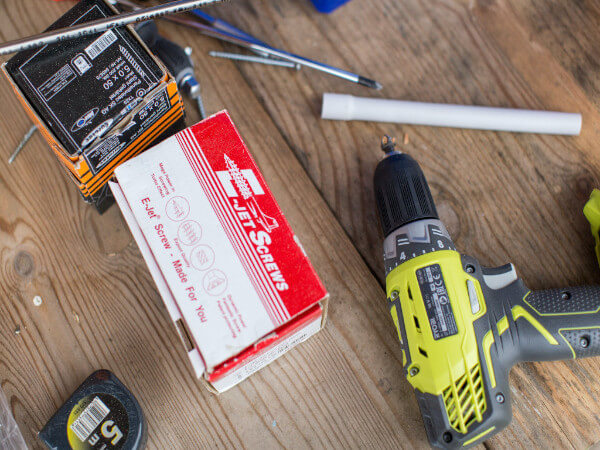
Chase Snyder, AEMP tech of the year, enjoys working on heavy equipment, like this large mower attachment.Manatee CountyThe county’s landfill shop tracks and keeps running more than 170 pieces of equipment, everything from golf carts to heavy-duty construction equipment. Snyder can fix and maintain it all, but his favorite is the yellow iron: excavators, landfill compactors, dozers and motor graders.
He’s always been fascinated by the heavy construction equipment, but the local trade school, Manatee Technical College, offered a degree in general automotive maintenance, not heavy diesel equipment. So he got his start on the automotive side in college and worked full time during the day on transit buses for a nearby municipality. After college, he landed at Manatee County.
His supervisor, David Alligood, remembers the job interview with Snyder at Manatee County. “We knew then that we had someone special,” he says.
Alligood should know. He was the 2020 AEMP Technician of the Year.
“He has a very strong work ethic,” Alligood adds. “He’s motivated by big jobs and challenges. His focus on the county’s budget and smart spending makes him an asset to our team. He is constantly self-educating.”
Coworker Christopher Brooks described Snyder as easy to get along with, smart and a talented technician. “He’s a go-getter – never says no to anything. If you ever need a hand, he’s willing to help you. He knows the equipment very well.”
Another colleague, who also worked with Snyder at the transit bus shop, says Snyder is always available to lend a guiding hand. “If I have a question, he always takes a few minutes to explain…how something works. He also keeps a great attitude, not only helping me but everyone in the shop.”
The Technician of the Year Award by the AEMP Education Foundation has been presented each year since 1989 to “the individual who exemplifies the heavy equipment profession’s best technician.” The award seeks candidates who constantly update their education, demonstrate a strong safety record, improve fleet operations and are always professional.
As this year’s winner, Snyder will receive a custom-built John Deere toolbox and merchandise and complimentary one-year membership to AEMP. He will also be the subject of an in-depth cover story on equipmentworld.com.
Deere has sponsored the award for 32 years.
Did you miss our previous article…
https://www.tortowheaton.com/?p=562
Loftness debuts Battle Ax H Series mulcher for skid steers, CTLs, tractors
Today’s skid steers and compact track loaders crank out lots of hydraulic horsepower, and Loftness is taking advantage of that with its new Battle Ax H Series mulching attachments.
Designed for machines with 33 to 62.9 gallons per minute and 50 to 150 hydraulic horsepower, these heavy-duty models chew up the brush with an 88-inch cutting width. The H series has a V-drive variable displacement piston motor that automatically shifts the rotor rpm from high to low for increased torque as needed. The result is less stalling and a shorter recovery time, which allows you to concentrate on the work instead of the power settings and repositioning the head.
A two-stage cutting chamber processes material thoroughly, and the primary shear bar is adjustable for controlling particle size. Other standard features include a synchronous belt drive, bearing anti-wrap protection, adjustable skid shoes and an on-board pressure gauge. Options include hydraulic or manual adjusting push bars, custom mounts and universal skid steer mounts, a hydraulic or manually adjustable tree pusher bar, and a trap door to help prevent the attachment from throwing material underneath the tractor.
The Battle Ax models feature a rotor with built-in depth gauges that function like the raker on a chain saw, preventing the cutting teeth from engaging too much material at one time. The mulchers can be used with reversible planer knives, hard-surfaced planer knives or double-edged carbide teeth. Single-bolt mounting allows the blades to be reversed or replaced on the jobsite with a hex socket and wrench.
And if you don’t have a skid steer or CTL, Loftness also introduced a new Battle Ax attachment for compact tractors. Designed for tractors with a 540 rpm PTO and 36 to 70 PTO horsepower, the PTO Battle Ax has a 61-inch cutting width and comes with a Category I hitch, but is adaptable to Category II, free-link or quick hitch.

Loftness Battle Ax attachment for tractors with PTOs.Loftness
Did you miss our previous article…
https://www.tortowheaton.com/?p=559
Will Construction Workers Walk? Implications of the Vaccine Mandate

Contractors with more than 100 employees are sitting in limbo as the Occupational Health and Safety Administration finalizes its guidance on vaccine mandates. OSHA sent its recommendations to the White House for review last week, and the final approval may be granted as soon as this week.
Once the Office of Management and Budget (OMB) completes its review and publishes the rule in the Federal Register, the rule will go into effect.
President Biden announced the executive order mandating COVID-19 vaccinations or weekly testing for employers with more than 100 employees in early September. Employees of contractors who do business with the federal government must get the vaccine; there is no option for routine testing in place of immunization.
Failure to comply will result in penalties costing $14,000 per violation. Large companies will also need to provide employees paid time off for vaccination as part of the rule. The policies will affect 100 million American workers.
Lagging Vaccination Rate
Vaccine mandates could have dire consequences for the construction industry, which is already plagued by worker shortages. Currently, 53% of the construction labor force is vaccinated, according to data from the Center for Construction Research and Training (CPWR), a nonprofit founded by building trade unions. Forty-one percent of the construction labor force says it’s hesitant to get the COVID-19 vaccine, CPWR says, with the top barrier being distrust of the government.
Because of the hesitancy to receive the vaccine, contractors with more than 100 employees may face the real threat of workers walking. Those reluctant to get the jab may opt to move to a smaller business that falls outside of the mandate.
Industry Groups Respond
Construction workers were among the first groups eligible to receive the vaccine, and industry associations have encouraged voluntary COVID-19 vaccination for their members and employees from the start. The Associated General Contractors of America and Associated Builders and Contractors say a mandate could put a strain on the industry, as well as the country’s infrastructure needs.
“Many of the challenges affecting contractors are being driven by the pandemic and policy responses to it, instead of typical market conditions,” said Stephen Sandherr, AGC chief executive officer,. “This federal contractor vaccination mandate could further exacerbate the industry’s workforce and significantly increases federal project costs and delays to the detriment of meeting vast federal government infrastructure needs.”
Ben Brubeck, ABC vice president of regulatory, labor and state affairs, echoed that sentiment, stating, “This guidance will result in additional compliance burdens, exacerbate the construction industry’s skilled- workforce shortage and increase costs for federal contractors and taxpayers. ABC is philosophically opposed to federal mandates that undermine the desired policy outcome.”
Conflicting requirements at the state level add to the confusion, with several governors announcing they will ban the vaccine mandate.
Did you miss our previous article…
https://www.tortowheaton.com/?p=552